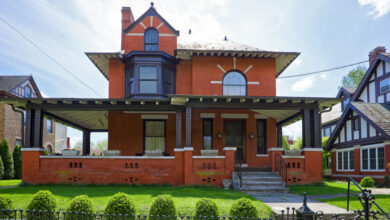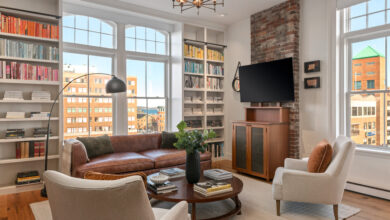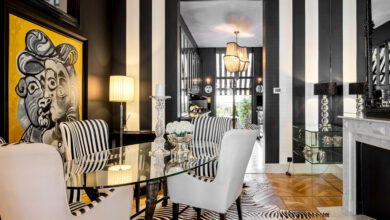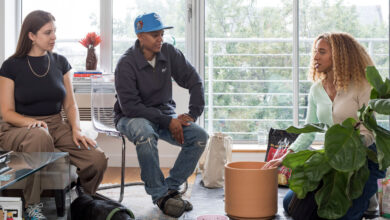Why the Best Gardens Have Something Extra
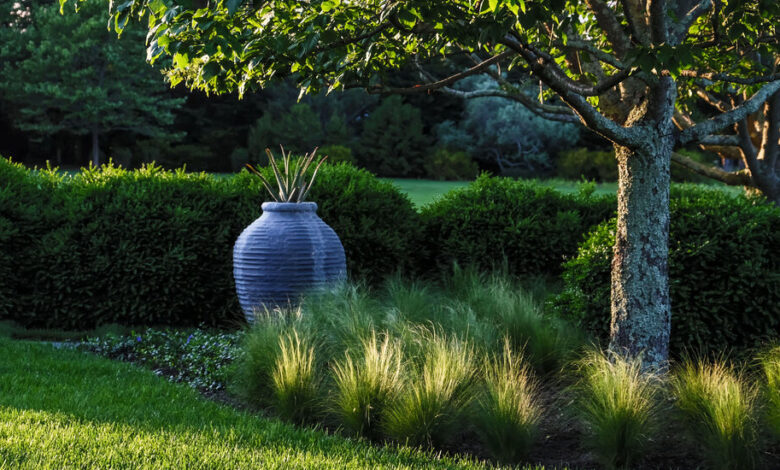
When you’re designing a garden, it’s natural to focus on what you’re planting. But flowers, trees and shrubs aren’t all there is to a visually appealing outdoor space.
Furniture, ornaments, statement pots, firepits, play features — they may not bloom like a favorite perennial, but they have an important role to play.
“These things draw people out into the landscape,” said Renée Byers, a landscape architect based in Greenwich, Conn. “They have a way of transforming a quote-unquote backyard into a garden.”
Landscape architects and designers shared some of their favorite ideas for using accessories to build on a garden’s natural appeal.
Create Places to Rest
One of the easiest ways to increase the time you can spend admiring the work you’ve done in the garden is to add some seating — not just in obvious places, like on a deck or around a pool, but out in the landscape. It could be a bench along a garden path or a couple of chairs under a shady tree.
Why? “It creates a destination” within the larger garden, Ms. Byers said.
Unlike patio furniture, pieces in the garden shouldn’t have upholstered cushions or need covers. They should be made from materials that can be left out all year without falling apart. For Ms. Byers, that frequently means benches made from natural stone or teak, she said, “or even some of the newer contemporary-style Adirondack chairs that are done in a wood composite.” Lounge chairs from Loll Designs are a popular choice.
But not all garden furniture needs to be heavy.
“One thing that people often skip, which I really think is necessary, is lightweight garden furniture,” said Flora Grubb, the owner of Flora Grubb Gardens, in San Francisco. “I love being able to move it around, to chase the shade or chase the sun, depending on the time of year.”
Small-scale powder-coated steel or aluminum chairs, like those made by Fermob and Bend Goods, are ideal. Choose pieces in earth tones if you want them to blend in, or in bright colors if you want to make a statement.
“I really think about how the color reads from far away,” Ms. Grubb said, because “most people spend just as much time looking at their garden from the house” as they do from outdoors.
Add a Sculptural Note
Statues and other ornaments have been a feature of grand gardens for centuries, but the idea of adding them to your backyard may seem intimidating. It doesn’t have to be.
Janice Parker, a landscape architect based in Greenwich, Conn., uses a range of statuary and ornaments in her projects, from geometric objects to pieces depicting rabbits, chickens and fish.
That not only creates a focal point in the garden, she said, but it also “makes it a very affectionate space. People become more attached to the outdoors in a loving manner, versus just saying, ‘Oh, this is pretty.’”
The statuary doesn’t have to be an expensive antique or a piece by a well-known artist. “Not everybody is going to go buy a Tony Cragg, a John Chamberlain or a Henry Moore — they’re not doing a sculpture park,” Ms. Parker said. “A lot of other things are very affordable, and I think they’re great.”
Options range from sea-inspired concrete pieces sold at many garden centers to cast-metal birds like those made by Viridian Bay. “Cranes, sandpipers and peacocks have become very popular again,” said Cathy Nakamura, a product merchandiser at Viridian Bay. “And we have flamingos that are a few steps up from those iconic hot-pink plastic flamingos.”
For a more minimalist look, Ms. Parker recommended fiberglass or concrete spheres, arranged in rows for an architectural statement or strewn about the garden in a random arrangement. “Any kind of spheres or orbs in the garden are wonderful,” she said. “They put a lighter element into the garden.”
Choose a Statement Planter
An alternative to statuary is to place a planter with an eye-catching shape or color in the garden, surrounded by vegetation planted directly in the ground. Ms. Grubb, for instance, has combined ribbed terra-cotta, chartreuse-glazed and gourd-shaped pots in her garden, including some that she left unplanted.
“With the pots I leave empty, they’re usually urn-shaped and tuck back in at the top,” she said, for a more interesting form. “Having big pots you can move around the garden as things change — to anchor something at the end of a path, to mark an area you’ve become interested in or to cover up something you don’t want to see for a period of time while it grows in — is helpful.”
Ms. Grubb has also transformed a single tall, white pot into a simple water feature by adding a pump inside, along with a basin buried in the gravel underneath to catch and recirculate overflowing water.
Light a Fire
Firepits do a few things very well: They can anchor a seating area in the garden as a destination away from the house, make cool evenings more comfortable and toast marshmallows for s’mores. So it’s no surprise that they’ve grown in popularity during the pandemic.
“We’ve seen a huge surge in outdoor firepits,” said Allison Messner, the chief executive and a founder of Yardzen, an online landscape design company. “Even when it was cold, people still wanted to be outside.”
Now that more people have embracing outdoor living, she expects the trend to continue, even as indoor entertaining returns.
Some firepits are built into a yard’s hardscaping and connect to buried piping for gas, but the setup doesn’t have to be that complicated. It’s possible to make your own wood-burning firepit by digging a broad, shallow hole in the ground and lining it with rocks. If you’d rather not dig a pit, prefabricated steel, iron and cement fire bowls are widely available from furniture retailers, including Design Within Reach and CB2; brands like Breeo, Solo Stove and Tiki make models designed to increase airflow, for less smoke.
And if you don’t want to commit to a full-size firepit, Ms. Parker suggested a pole-mounted torch. In addition to traditional bamboo Tiki torches, there are artisanal models available, she said, like the handblown glass torches on copper poles from Arch One Glass. “When you’re sitting outside at night, it’s just magical,” she said.
If you’re worried about introducing open flame into the landscape, try candle lanterns with glass doors or LED-powered portable lanterns.
Install Interactive Elements
Accessories that move and change with the weather — or offer an opportunity for play — provide more reasons to get out into the garden.
Rain gauges and catchers show off the results of an overnight storm. Suncatchers sparkle on bright days, and wind chimes and bells sing with the passing breeze.
More playful elements can appeal to children and adults. The attraction of a tree swing, for instance, is almost universal. “I’ve rarely seen someone be able to resist a swing,” said Ms. Parker, who has put them in a number of her projects.
The designers at Yardzen aren’t seeing much demand for stand-alone swing sets and slides these days, Ms. Messner said. Instead, many parents are asking for integrated play elements — like bespoke tree houses that can serve various functions over time.
“It’s not just something for toddlers or school-age kids,” she said. When the children grow up, the grown-ups “have a vision for how they’re going to use it as an art studio.”
For weekly email updates on residential real estate news, sign up here. Follow us on Twitter: @nytrealestate.


